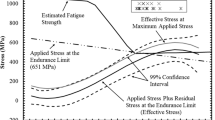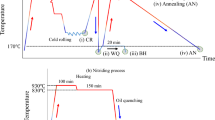Abstract
The variation in fracture toughness of low-alloy base steels and weld steels with carbon contents of 0.08 and 0.21 wt pct was investigated using notched and precracked specimens tested at low temperatures. The attention is focused on the mechanism associated with detrimental effects on cleavage fracture toughness resulting from increasing carbon content. Analyses reveal that, in the case of constant ferrite grain sizes with increasing carbon content, the yield stress σ y increases and the local fracture stress σ f remains constant for notched specimens. For precracked specimens, the σ y increases, whereas the σ f decreases. In both cases, the ratio σ f /σ y decreases; this ratio is one of the principal factors inducing the deterioration in the cleavage fracture toughness of the higher carbon steels. Analyses also reveal that the critical strain for initiating a crack nucleus, which decreases with increasing carbon content and impurity elements, appears to be another principal factor that has a negative effect on the fracture toughness in both notched and precracked specimens. The results of the fracture toughness measured for weld metal with various grain sizes further support the predominant effect of grain size on the toughness of notched specimens.
Similar content being viewed by others
References
C.J. McMahon Jr. and Morris Cohen: Acta Metall., 1965, vol. 13, pp. 591–604.
E. Smith: Proc. Conf. on Physical Basis of Yield and Fracture, Institute of Physics and the Physical Society, London, 1966, pp. 36–46.
D.E. Hodgson and A.S. Tetelman: Proc. 2nd Int. Conf. on Fracture, Brighton, 1969, pp. 266–77.
D.A. Curry and J.F. Knott: Met. Sci., 1978, vol. 11, pp. 511–14.
J.H. Chen, L. Zhu, G.Z. Wang, and Z. Wang: Metall. Trans. A, 1993, vol. 24A, pp. 659–67.
P. Brozzo, G. Buzzichelli, A. Mascanzoni, and M. Mirrabile: Met. Sci., 1977, Apr., pp. 123–29.
G.Z. Wang and J.H. Chen: Int. J. Fract., 1998, vol. 89, pp. 269–84.
A.W. Thompson and J.F. Knott: Metall. Trans. A, 1993, vol. 24A, pp. 523–34.
J.R. Griffiths and D.R.J. Owen: J. Mech. Phys. Solids, 1971, vol. 19, pp. 419–29.
C. Yan, J.H. Chen, J. Sun, and Z. Wang: Metall. Trans. A, 1993, vol. 24A, pp. 1381–89.
J.H. Chen, C. Yan, and J. Sun: Acta Metall. Mater., 1994, vol. 42, pp. 251–61.
J.H. Chen and G.Z. Wang: Metall. Trans. A, 1992, vol. 23A, pp. 509–17.
J.H. Chen, L. Zhu, and H. Ma: Acta Metall. Mater., 1990, vol. 38, pp. 2527–35.
J.H. Chen, G.Z. Wang, and H. Ma: Metall. Trans. A, 1990, vol. 21A, pp. 321–30.
T. Miyata, R.C. Yang, A. Otsuka, T. Haze, and S. Aihara: in Advances in Fracture Research, Proc. ICF6, Houston, TX, 1989, K. Salama, K. Ravi-Chandar, D.M.R. Taplin, and P. Rama Rao, eds.
Author information
Authors and Affiliations
Rights and permissions
About this article
Cite this article
Chen, J.H., Wang, G.Z. & Hu, S.H. Mechanism of detrimental effects of carbon content on cleavage fracture toughness of low-alloy steel. Metall Mater Trans A 32, 1081–1091 (2001). https://doi.org/10.1007/s11661-001-0119-5
Received:
Issue Date:
DOI: https://doi.org/10.1007/s11661-001-0119-5




